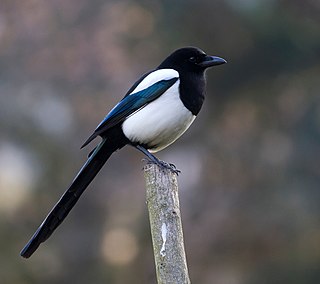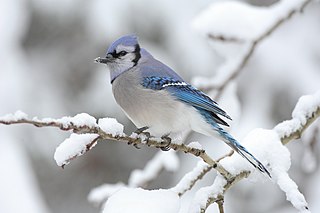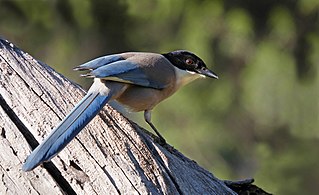
Magpies are birds of the Corvidae family. Like other members of their family, they are widely considered to be intelligent creatures. The Eurasian magpie, for instance, is thought to rank among the world's most intelligent creatures, and is one of the few non-mammal species able to recognize itself in a mirror test. They are particularly well known for their songs and were once popular as cagebirds. In addition to other members of the genus Pica, corvids considered as magpies are in the genera Cissa, Urocissa, and Cyanopica.

Corvidae is a cosmopolitan family of oscine passerine birds that contains the crows, ravens, rooks, jackdaws, jays, magpies, treepies, choughs, and nutcrackers. In colloquial English, they are known as the crow family or corvids. Currently, 133 species are included in this family. The genus Corvus, including the crows, rooks, and ravens, makes up over a third of the entire family. Corvids (ravens) are the largest passerines.

The Eurasian magpie or common magpie is a resident breeding bird throughout the northern part of the Eurasian continent. It is one of several birds in the crow family (corvids) designated magpies, and belongs to the Holarctic radiation of "monochrome" magpies. In Europe, "magpie" is used by English speakers as a synonym for the Eurasian magpie: the only other magpie in Europe is the Iberian magpie, which is limited to the Iberian Peninsula.

The azure-winged magpie is a bird in the crow family. It is 31–35 cm long and similar in overall shape to the Eurasian magpie but is more slender with proportionately smaller legs and bill. It belongs to the genus Cyanopica.

Pica is the genus of seven species of birds in the family Corvidae in both the New World and the Old.

The genus Perisoreus is a very small genus of jays from the Boreal regions of North America and Eurasia from Scandinavia to the Asian seaboard. An isolated species also occurs in north-western Sichuan province of China. They belong to the Passerine order of birds in the family Corvidae. Not closely related to other birds known as jays, they are instead related to the genus Cyanopica.

The family Cisticolidae is a group of about 160 warblers, small passerine birds found mainly in warmer southern regions of the Old World. They were formerly included within the Old World warbler family Sylviidae.

The piapiac is an African bird in the crow family, and is the only member of the genus Ptilostomus. According to recent findings, it is most closely related to the Central Asian ground jays.

Tailorbirds are small birds, most belonging to the genus Orthotomus. While they were often placed in the Old World warbler family Sylviidae, recent research suggests they more likely belong in the Cisticolidae and they are treated as such in Del Hoyo et al. One former species, the mountain tailorbird, is actually closer to an old world warbler genus Cettia.

Gurney's pitta is a medium-sized passerine bird. It breeds in the Malay Peninsula, with populations mainly in Myanmar. The common name and Latin binomial commemorate the British banker and amateur ornithologist John Henry Gurney (1819-1890). Its diet consists of slugs, insects, and earthworms.

The white-throated magpie-jay is a large Central American species of magpie-jay. It ranges in Pacific-slope thorn forest from Jalisco, Mexico to Guanacaste, Costa Rica. Magpie-jays are noisy, gregarious birds, often traveling in easy-to-find flocks, mobbing their observers.

The scrubtit is a species of bird in the thornbill family Acanthizidae. It is endemic to Tasmania and King Island in Australia. Its natural habitat is the temperate rainforest, Nothofagus beech forest and eucalypt woodland. It is a small species that resembles the Sericornis scrubwrens.

Dohrn's warbler, also known as Principe flycatcher-babbler, Dohrn's flycatcher, Dohrn's thrush-babbler, is a species of passerine bird in the family Sylviidae that is endemic to the island of Príncipe which lies off the west coast of Africa in the Gulf of Guinea.

The melampittas are a family, Melampittidae, of New Guinean birds containing two enigmatic species. The two species are found in two genera, the greater melampitta in the genus Megalampitta and the lesser melampitta in the genus Melampitta. They are little studied and before being established as a family in 2014 their taxonomic relationships with other birds were uncertain, being considered at one time related variously to the pittas, Old World babblers and birds-of-paradise.

The red-fronted prinia, also known as the red-fronted warbler and the red-faced apalis, is a species of bird in the family Cisticolidae. It is found in Chad, Djibouti, Eritrea, Ethiopia, Kenya, Somalia, Sudan, Tanzania, and Uganda. Its natural habitat is dry savanna.

The fulvous babbler or fulvous chatterer is a species of bird in the family Leiothrichidae. It is 25 cm long with a wingspan of 27–30.5 cm. It is warm brown above with very faint streaking on the crown and back. The throat is whitish and the rest of the underparts are pale brown.

The black-rumped magpie is a species of magpie found in central Bhutan to west-central China. It was formerly classified as a subspecies of the Eurasian magpie.

The Iberian magpie is a bird in the crow family. It is 31–35 cm (12–14 in) long and similar in overall shape to the Eurasian magpie but is more slender with proportionately smaller legs and bill. It belongs to the genus Cyanopica.

Artamidae is a family of passerine birds found in Australia, the Indo-Pacific region, and Southern Asia. It includes 24 extant species in six genera and three subfamilies: Peltopsinae, Artaminae and Cracticinae. Artamids used to be monotypic, containing only the woodswallows, but it was expanded to include the family Cracticidae in 1994. Some authors, however, still treat the two as separate families. Some species in this family are known for their beautiful song. Their feeding habits vary from nectar sucking (woodswallows) to predation on small birds.
The Asir magpie, also known as the Arabian magpie, is a highly endangered species of magpie endemic to Saudi Arabia. It is only found in the country's southwestern highlands, in the Asir Region. It occurs only in African juniper forest in well-vegetated wadis and valleys. It was formerly classified as a subspecies of the Eurasian magpie, and still is by many authorities. This species is highly threatened by habitat destruction, as its native forests are not regenerating. Tourism development and climate change are also posing a threat. Only 135 pairs are known to survive in the wild, and this number is declining.






















